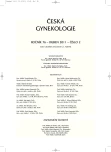Importace of the consultation for combined hormonal contraception’s choice - results of CHOICE project in Czech and Slovak republic
Authors:
Tomáš Fait 1; I. Apetauer 2
Authors‘ workplace:
Gynekologicko-porodnická klinika 1. LF UK a VFN, Praha, přednosta prof. MUDr. A. Martan, DrSc.
1; Medicínské oddělení Schering-Plough, s. r. o., Praha, ředitelka MUDr. S. Martínková
2
Published in:
Ceska Gynekol 2011; 76(2): 140-144
Overview
Objective:
The aim of this project was to evaluate influence of standardised information on patient’s choice of combined hormonal contraception application way.
Design:
Non-interventional, multicentric, prospecive study.
Setting:
Dept. of Obstetrics and Gynecology, 1st Faculty of Medicine, Charles University Prague.
Methods:
The choice of application form of combined hormone contraception was evaluate in group of 1944 women in 183 centers of Czech and Slovak republic before and after doctor’s consultation.
Results:
The 1911 women have given replay for all questions. Percentage of women prefering combined oral contraception (46.6%, CI 95% 44%-50%, 906 women) and transdermal patch (4.5%, CI 95% 3%‑6%, 87 women) were unchanged. Choice of vaginal ring grew up from 6.2% to 42.6% (CI 95% 40%-46%, 837 women). It means significant elevation by 36.4% (CI 97.5% 33.9% – 38,9%, p < 0.0001). Vaginal ring was choosen by 54.2% of women without any intention and 39.1% from women with preference of nonhormonal contraception.
Conclusion:
Project show to increase the preference of vaginal ring by information about all application forms of combined hormonal contraception.
Key words:
combined hormonal contraception, pill, vaginal ring, patch, CHOICE project.
Sources
1. Fiebig, DG., Knox, S., Viney, R., et al. Preferences for new and existing contraceptive products. Health Econ. 2010 Nov 24. [Epub ahead of print].
2. Kaminskyy, V., Bitzer, J., Tatarchuk,T., Oddens, B. Contraceptive health education research program in women considering combined hormonal contraception: CHOICE (Contraceptive Health Research of Informed Choice Experience) results from Ukraine. Eur J Contracept Health Care, 2010, 15, Suppl 1, p. 57.
3. Kocourková, J. Potratovost s. 39-44. In Populační vývoj České republiky 2001-2006. Praha: Katedra demografie a geodemografie PřF UK Praha, 2007, 112 s.
4. Kost, K., Singh, S., Vaughan, B., et al. Estimates of contraceptive failure from the 2002 National Survey of Family Growth. Contraception, 2008, 77(1), p. 10-21.
5. Langston, AM., Rosario, L., Westhoff, CL. Structured contraceptive counseling – A randomized controlled trial. Patient Educ Counsell, 2010, 81, p. 362-367.
6. Lete, I., Doval, JL., Pérez-Campos, E., et al. Factors affecting women’s selection of a combined hormonal contraceptive method: the TEAM-06 Spanish cross-sectional study. Contraception, 2007, 76(2), p. 77-83.
7. May, WL., Johnson, WD. A SAS macro for constructing simultaneous confidence intervals for multinomial proportions. Computer methods and programs. Biomedicine, 1997, 53, p. 153‑162.
8. Saeed, GA., Fakhar, S., Rahim, F., Tabassum, S. Change in trend of contraceptive uptake-effect of educational leaflets and counseling. Contraceptin, 2008, 77, p. 377-381.
9. Shunmann, C., Glacier, A. Specialist contraceptive counselling and provision after termination of pregnancy improves uptake of long-acting methods but does not prevent repeat abortion: a randomized trial. Hum Reprod, 2006, 21, p. 2296-2303.
Labels
Paediatric gynaecology Gynaecology and obstetrics Reproduction medicineArticle was published in
Czech Gynaecology

2011 Issue 2
Most read in this issue
- Extended embryo culture in IVF does not improve pregnancy rate
- Uterine fibroids and their treatment
- Luteal support in the IVF/ET programme
- Decreased fertility and today’s possibility of examination in reproductive immunology
